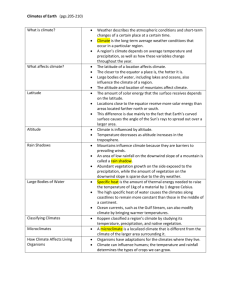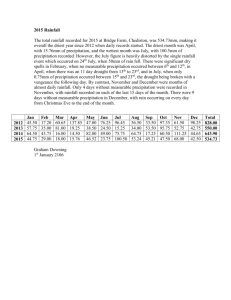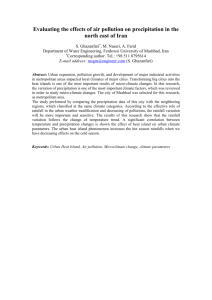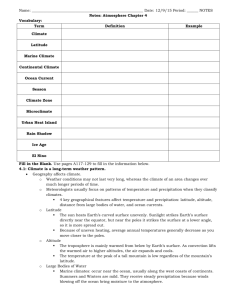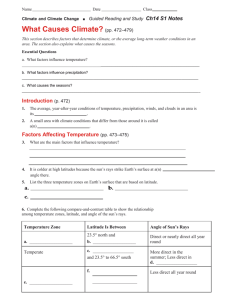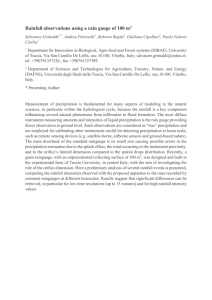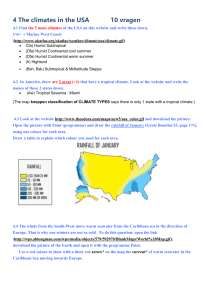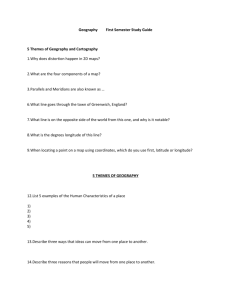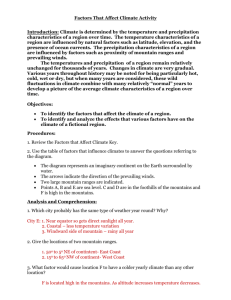Climate - misslaurent
advertisement
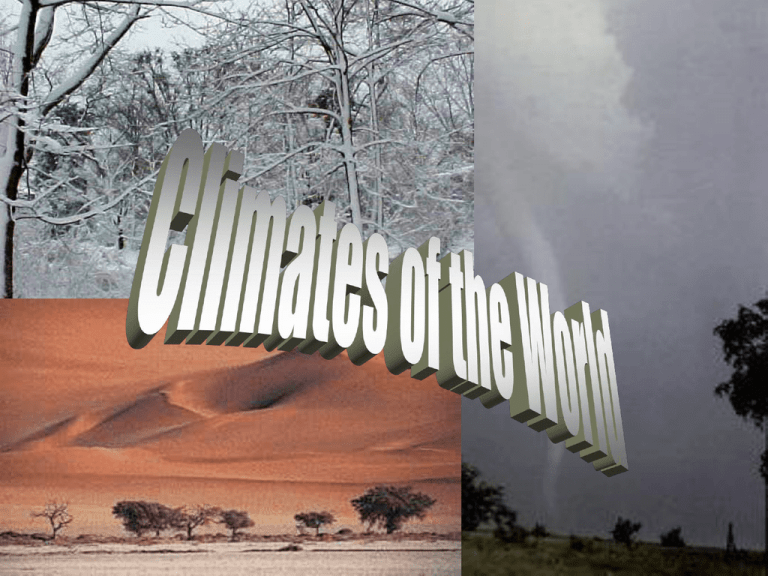
A) CLIMATE VS. WEATHER • Climate is the weather pattern in one place over a long period of time • Weather is the current atmospheric conditions, including temperature, rainfall, wind, and humidity at a given place B) Earth’s Tilt & Rotation • Tilt affects the temperature of places. - Earth makes one rotation on its to cause day & night. - Earth takes 365 1/4 days to revolve around the sun. C) THE SEASONS • Earth’s revolution & the tilt create seasons • March 21st • Sun’s rays fall directly on equator • Equinox (equal night) • Tropic of Capricorn • 23 ½ degrees South • December 22nd • Shortest day of sunlight in northern hemisphere • Winter solstice • Tropic of Cancer • 23 ½ degrees North • June 21st • Earth moves so sun falls on this latitude. • Longest day of sunlight in northern hemisphere • Summer solstice D) THE GREENHOUSE EFFECT • Earth’s atmosphere acts as a like in a greenhouse- it traps sun’s energy. • Greenhouse Effect• Atmosphere provides just the right amount of insulation to promote life. • Sun’s radiation turns into heat. • Global warming • Some scientists believe there is a rise in CO 2 levels (carbon dioxide). More heat is trapped. WHY GLOBAL WARMING? • Human activityburning of coal, oil, and natural gas (releases CO2) • Or natural? E) FACTORS AFFECTING CLIMATE • 1) Latitude - rays of sun & how it strikes the earth (low latitudesun year-round). • 2)Elevation- atmosphere gets thinner (thinner air retains less heat…not as dense) as altitude increases. • 3) Wind & Ocean current - ex. Prevailing winds - blow in constant patterns. • 4) Landforms- water slower to heat than land, so land near water has consistent temp. WIND PATTERNS • Wind blows because of temperature differences on the surface. • Earth rotates to the east, the global winds are displaced clockwise in the north) OCEAN CURRENTS • Cold and warm streams of water move through oceans (based on earth’s rotation, differences in water temperature, and change in air pressure. WEATHER AND THE WATER CYCLE • Wind & water work together to affect weather= precipitation • El Nino- recurring climatic event • Low atmospheric pressure rises over the western pacific, while the high pressure over the eastern pacific lowers LANDFORMS AND CLIMATE • The presence (or absence) of landforms affect climate. • Large bodies of water are slower to heat than land (so land temps aren’t consistent). • Mountains also influence precipitation and climate. • Winds are pushed upward when meet a mountain range. • This releases moisture and causes rain on windward side. TYPES OF CLIMATES: F) LOW LATITUDE-TROPICAL • Hot and muggy the year around. • Rain forests • Average annual rainfall varies from about 70 to 100 inches • Average 80 degrees F for high temp. • Low temp range of all climates G) LOW TO MIDLATITUDE • Little precipitation. • Steppe climate usually borders desert climates. • Desert rainfall is 10 inches (Steppe b/t 10 and 20 inches) • Covers 24% of land H) MID-LATITUDE- MEDITERRANEAN • Warm to hot, dry summers and mild, rainy winters. • On the west side of continents • Between 30 degrees and 45 degrees latitude. • Southern California • SF I) HIGH-LATITUDE SUBARTIC • Short, cool summers and long, bitterly cold winters. • Needle-leaved evergreen trees • Most precipitation falls in the summer. J) HIGH-LATITUDE ICECAP • Coldest on earth. • Summer temperatures rarely rise above the freezing point. • Supports no vegetation. • Precipitation is meager and is almost always in the form of snow. K) HIGHLAND • In mountainous regions. • Varies with elevation. • Evergreen & Deciduous trees grow at base of mountains. COUNTRY CLIMATE BROCHURE • You will create a brochure for one particular climate in groups of 4. • You will attempt to sell a visit to one location/ country that has the climate assigned to you. • Must be colored/in pen with appropriate titles for each section. • Due _______________ • For the brochure you must do the following: • The Country (Pick on country to focus on- Use pg. 53 in text & Internet to identify country) - Slogan (on cover, with name of country & climate & small pic) INSIDE • What to Do (five activities w/ one sentence description. For each). • What to Wear (five appropriate clothing attire identified) • What to Expect (Five descriptive sentences about climate features… “Amazingly, the desert covers 24 % of the world’s landmass”) • 7 Pictures (no title needed, but must be colored and have a caption for each picture). -- Why Visit? (4-6 sentence paragraph to sell your country/climate!) • Where to Visit (Select five other countries to visit that have same climate region and list). As a note - you must describe what each person did on project on brochure.
